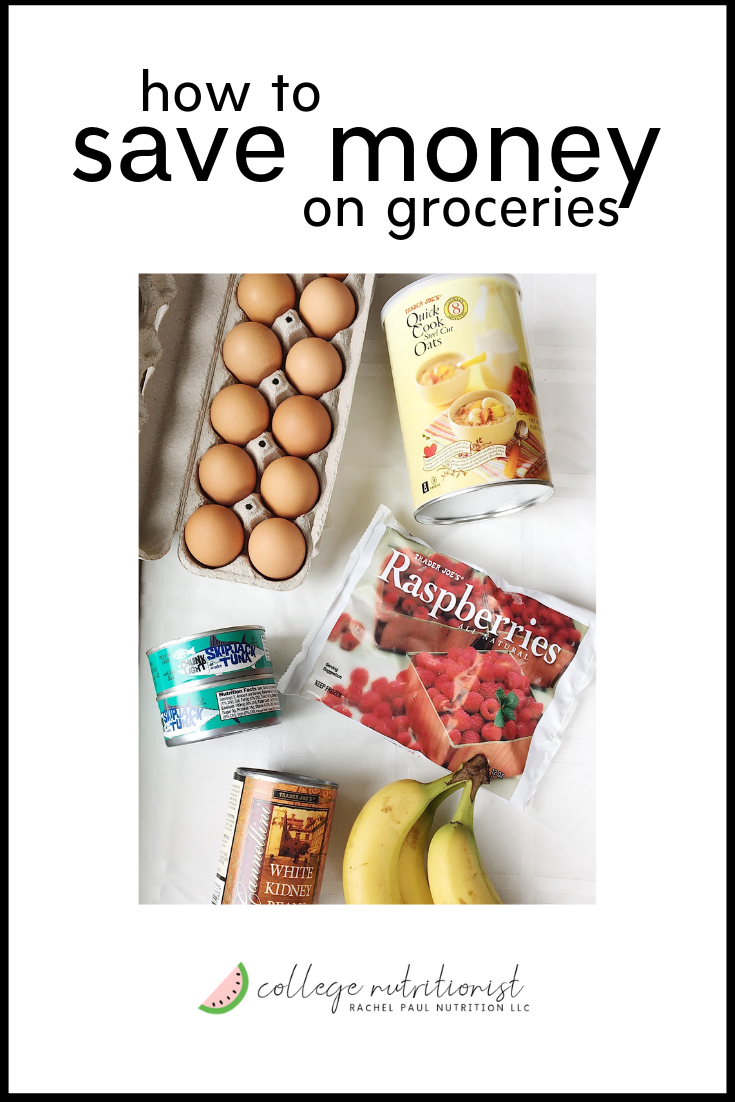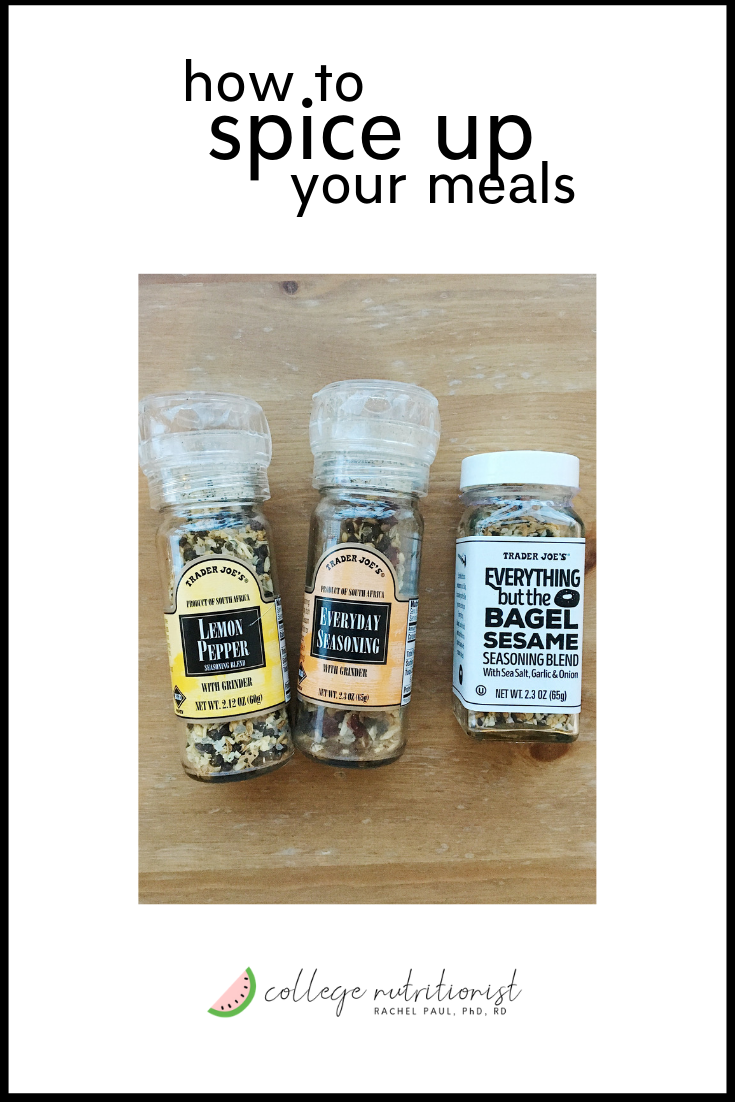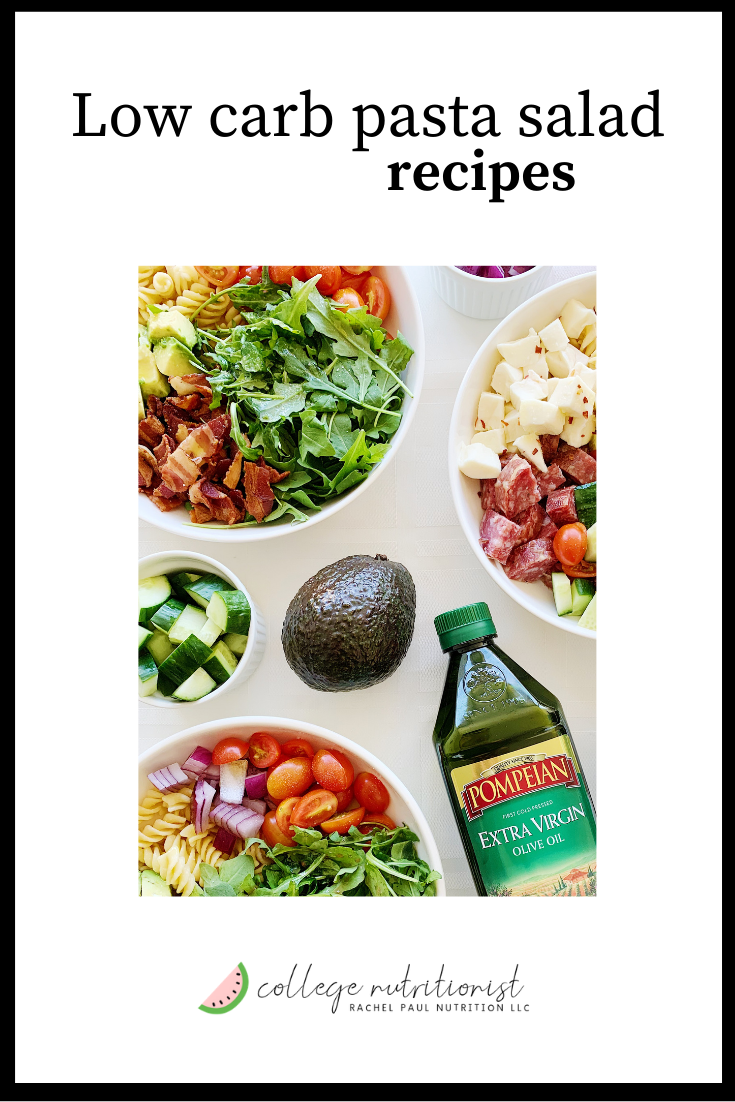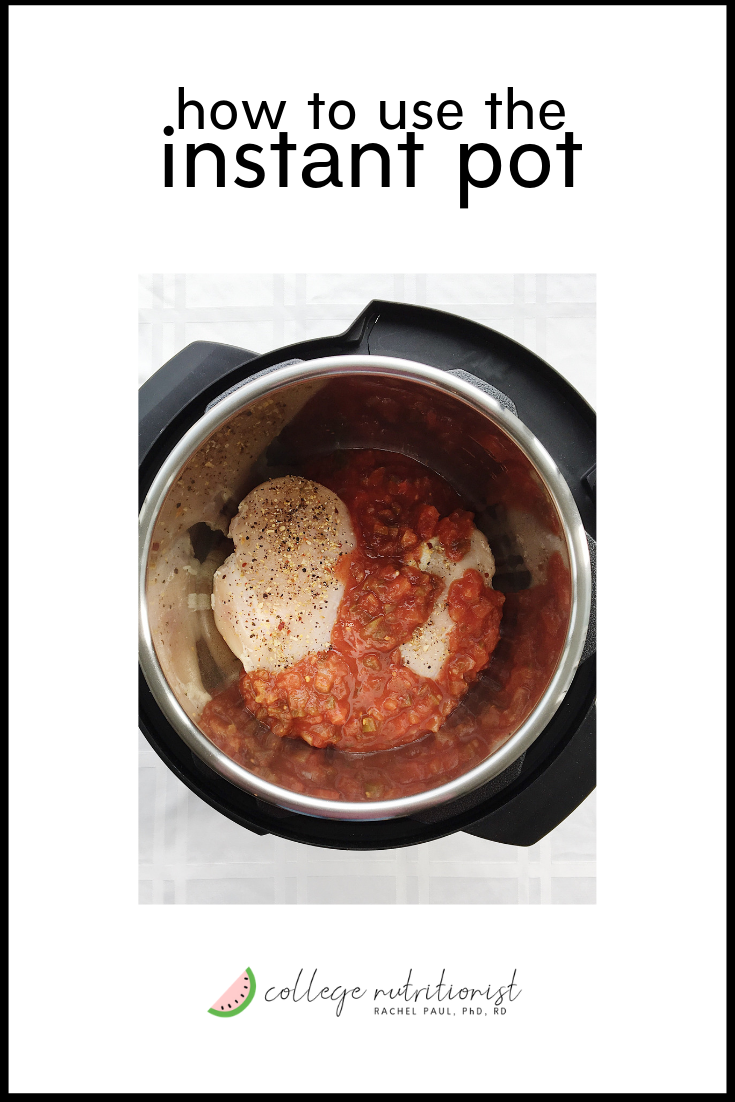I was tight on cash throughout my 20s – so I absolutely hear you when you tell me that saving money on groceries is one of your top priorities. Here are some of my top tips that have worked for me over the YEARS to help me manage my weight, save money, and get optimal nutrition.
How To Save Money On Groceries
1. Make A Meal Plan Ahead Of Time
Planning is SO key – I know this for myself, and I hear this from my clients and those taking my course all the time. Even though planning is key – it does NOT have to be stressful! I know it can seem like this big, daunting task. But as I’ll show you here, it 100% does not have to be.
I typically recommend planning 2 sets of meals: one for Monday through Wednesday, and one for Thursday and Friday. This way, you won’t get too sick of what you’re eating throughout the week. For example, you could plan:
- BREAKFAST Mondays – Wednesdays: 2 hard boiled eggs + 1 apple + 1 string cheese
- BREAKFAST Thursdays – Fridays: 1 to-go oatmeal cup + 1/4 cup nuts
- LUNCH Mondays – Wednesdays: 1 can tuna + 1 Tbsp mayo + 2 cups celery +
- LUNCH Thursdays – Fridays: 2 hard boiled eggs + 2 cups baby carrots + 2 single-serving packets of guacamole
Also, here are some good articles on how to create meals and snacks:
So, you have to plan your meals first before you can make a money saving grocery list, and sticking to it will be easier to do once you have a plan and know what you want to eat throughout the week.
2. Be Realistic About How Often You Will Eat Out
When creating your meal plan, try to be realistic about how often you will eat out. If chicken & veggies or fruits and veggies, just aren’t going to cut it on Friday night, don’t even plan (and buy groceries) to last you that long. Not only will this help you cut back on grocery prices, but you can redirect those funds towards where your money will go anyway and avoid food waste as well.
You will end up SAVING money in the end when you plan for what is realistic in your life!
3. Buy Certain Foods In Bulk
Especially once you get the hang of meal prepping and shopping for yourself, buy certain foods in bulk that you know you’ll get through. Not only will this save you in shopping trips, but it can help you see improvements in your bottom line over time. I recommend the foods listed below as ones to buy in bulk if you can – e.g. at the grocery store or at bigger stores like Costco. These foods last a long time – which is important especially if you’re only cooking for yourself.
- Frozen non-starchy veggies like carrots, broccoli, cauliflower, spinach, and green beans
- Packs of nuts like peanuts, cashews, etc. (or better yet, get a variety!) – if you want to make your own little packs, go ahead by all means! For me, it’s worth it to buy the pre-packaged packs because I’m pretty lazy
- Jerky – lasts for so long
- Frozen protein – like burger patties, shrimp, chicken breasts
4. Use The Freezer
Of course, first, think about how much room you actually have in your fridge! You may be surprised to hear this from a nutritionist, but frozen food is one of my all time fave kinds of food when you’re looking to cut back on food prices. I love using the freezer and the pantry – this way, I can eat exactly what I want, when I want it, and not worry that I have all this fresh food in the fridge that’s going to go bad.
Here are some good foods to stock up on:
- Frozen non-starchy vegetables, such as spinach, broccoli, cauliflower, etc.
- Frozen proteins such as turkey burger and regular burger patties, shrimp, fish filets, etc.
- Frozen meals low in starchy foods, such as Trader Joe’s frozen spinach & artichoke dip (eat it like a soup – SO good). Added starch and sugars already hide in so many of our foods – which is why I recommend searching for frozen meals that don’t blatantly have a starch in them (like pasta, rice, quinoa, etc.). These are of course healthy options – but it’s very easy to overeat them.
5. Use The Pantry
Similar to the freezer – stock up on wholesome, healthy options in the pantry that last for months! This way, again, you can eat what you want, when you want it. Here are some of my faves:
- Low-carb snacks like baked cheese “crackers” (also called “crisps” or “whisps” depending on the brand!), turkey or beef jerky, and single-serving packs of nuts or nut butters
- Canned tuna and salmon
- Canned tomatoes and beans (great for making chili, or adding to a stir-fry!)
6. Include Certain Foods That Are Always Cheap
Some foods are (typically) always cheap – or cheaper – than other foods:
- Produce sold in a bag versus produce you buy individually (e.g. 4 avocados sold in a mash bag vs. buying 4 individual avocados)
- Oatmeal is a cheap whole grain that stays in the pantry for months (years?)
- Frozen veggies and fruits are typically cheaper than fresh – they have very similar nutrient qualities, and then you don’t have to worry about
eating them quickly! - Eggs are one of the cheapest complete protein sources
- Canned tuna is also a cheap, complete protein source (by complete, I mean includes all of the amino acids – versus veggie protein sources which only include some amino acids)
- Canned beans are v. cheap also – canned food lasts months! Try to find ones with easy-open lids
- Bananas are typically the cheapest fresh fruit
7. Know What To Buy In Single-Servings
I’m a big proponent of making our lives as easy as possible. This is why I generally recommend buying some foods in single-serving packages to help with portion control.
It’s absolutely true that more packaging = more waste. If you can make little packages yourself, please do so! This is always my intention, but then life and general business gets the best of me. At this point in my life, buying single-serving packages is the way to go! Here’s my list of top foods to buy in single-serving packages.
You may think – how does this save money? Aren’t single-serving packages more expensive? This is true at face value, but let me tell you, it’s very common for us to eat multiple servings at once if we eat chips from the bag or peanut butter from the jar. It’s very likely that you will SAVE money in the long run if you spend a little extra up front to buy single-serving packages.
8. Know Your “Food Facts”
One of my favorite authors Gretchen Rubin has these “commandments” or “facts” that relate to her as a person. These are her “truths”. For example, one of my food facts is that “Protein bars don’t fill me up”. It doesn’t make sense for me to buy new ones or (especially) ones I’ve already tried before because that’s a waste of money!” This is a personal fact about me. It doesn’t matter what’s true for other people.
It’s important to know your own personal truths or “commandments” so that we can know what foods to buy, and which foods we can say adios to.
9. Finally, Make A Grocery List
Based on your meal plan, which should take into account tips 2-8 above, make a shopping list that includes what you are going to eat for the week. You may need to buy certain foods (like the frozen and pantry varieties) only once or twice per month, so also account for this!
Having a list can also help you with impulse purchases – when you have a shopping list on hand when you go grocery shopping, you can easily stick to it! Also, paying attention to the shopping list is important as well!
Honestly, I just make a list of my groceries in the Notepad on my phone, but in my course we have a more structured grocery list! Here’s a good general checklist, but again, your specific grocery list should reflect what exactly you’re eating. This list is based on my weight management philosophy!
Whole Grains and Starchy Veggies – Select 1-2 whole grains and/or starchy veggies for the week – like popcorn, oatmeal, whole wheat bagels, etc.
Veggies – Choose both fresh and frozen non-starchy veggies. Starchy veggies include potatoes, beans, corn, peas, and winter squash, so non-starchy veggies are all the rest!
Protein – Choose a few protein sources. When thinking about protein and cuts of meat, some good ones that last a while include eggs, canned tuna or salmon, and frozen chicken breasts, burger patties, etc.
Fats – Choose some fats such as avocados or single-serving packs of guacamole, cheese, bacon, olives, nuts and nut butters.
Toppings – Let’s be real we need our food to taste good! Here are some that I like best:
- Salsas
- Low calorie salad dressings (under 50 calories per 2 Tbsp)
- Sauerkraut or pickles
- Mustards (except honey mustard)
- Pre-mixed seasoning blends (like TJ’s Everything But the Bagel seasoning, or any of the Mrs. Dash varieties!)
10. Just Because There’s A Sale, Does NOT Mean You Need To Buy It
This is something I learned the hard way! And I saw my grandpa fall prey to this all the time Love you, grandpa. JUST because a certain food is on sale, does NOT mean you should buy it! You may very well end up eating that food, maybe in a large quantity, not be satisfied or be over-stuffed, and wish you had made a different choice. So, just because something is a sale price, doesn’t mean you should get it!
11. Just Because Something Is Healthy – Does NOT Mean You Need To Buy It – Know Your Food Likes And Dislikes
Another thing I learned the hard way was to not fall prey to the newest health fad or buying something just “for the health of it”! This really, in the end, comes back to what our true food likes and dislikes are. What foods do you love – do you love the taste of and that you feel nourish your body? And which foods can you go without? For example, for me, here are some of my…
FOOD LIKES
- TJs Cauliflower Crust Pizza
- Milk chocolate
- Grilled chicken and grilled salmon
- Cucumbers and sliced, crisp (important!) tomatoes
- Etc.
FOOD DISLIKES
- Plain yogurt (without e.g. adding fruit)
- Kimchi, kefir
These foods are very healthy, I just don’t prefer the taste or smell! Therefore, there not foods I
have in my grocery list rotation, and that is perfectly fine.
12. Keep Track Of Your Expenses. Where Do You Overspend?
Do you buy a coffee every morning? Do you automatically reach for brand items just because it’s popular or do you ever consider the dupe or to buy generic? Do you eat out for lunch even after you’ve brought something from home that’s already waiting for you in your work fridge? Keep track of your expenses for at least 2 weeks to see the truth come out! Some ways to do this are to log everything on your phone, or use an app (many banks have this already built into their own apps), or keep track with an excel document on your computer.
13. Set A Budget For Yourself
A good trick to also use is setting a grocery budget, or limited amount of $ you will spend on grocery shopping per week. It may be a good idea to set different budgets, e.g.:
- One for weekly groceries
- One for eating out – morning coffee, lunch on-the-go, dinners out with friends, etc.
This of course varies on your stage in life, your income, etc.
A good thing to do at first is to keep track of how much you actually spend. Spend 2 weeks doing this at first. Keep track on your phone, write it down, or use an app like Mint (many banks though have their own apps you can use!). Here’s what I personally do:
- I spend about $50-60 on groceries each week
- I spend about $50 on coffee, seltzer, and other little “treats” I buy out per week
- I spend about $100 per week on going out with friends and my boyfriend
- I also spend some extra money on food to take pictures of for you guys – but not including that here since it’s irrelevant to our discussion!
So, this totals about $200 per week – that can seem like a lot, BUT I bet if you tracked everything you ate out and the groceries you bought, it may be a similar story.
Another great tip is to compare prices with store brands when you’re grocery shopping – it can help you save extra money!
14. Use Cash To Your Benefit
I also take out $100 in cash about once every 3 weeks – many places in NYC only accept credit cards with a $5 or $8 minimum purchase. This way, I don’t have to buy the gum and the nuts and the iced coffee to get to $5 – I can just get my $2 pack of nuts and be on my way! Taking out cash can also be helpful for budgeting – maybe you want to spend $100 in the whole week on groceries and eating out. Taking out $100 in cash at the start of each week can work wonders.
15. Don’t Go To The Grocery Store Hungry
I’m sure you’ve heard this one before! When we’re hungry, we’re more likely to make impulse buys at the grocery store and end up grabbing basically whatever is at eye level. Eat a hardy meal before you go grocery shopping will help you stick to the list and ultimately save money on groceries.






